What are hydrodynamic alterations?
Hydrodynamic alteration of estuaries and coastal waterways refers to any modification to the entrance or shoreline which can influence the volume, frequency, and duration of flow of water that enters (flood tides) or exits (ebb tides) the waterway. This process is also known as ‘marine flushing’, and has important implications for the physical, chemical and biological condition of coastal waterways. The efficiency of marine flushing is very sensitive to changes in water depth close to the estuary mouth.
What are the causes of hydrodynamic alterations?
Artificial entrance opening
Entrance opening involves the manual digging out of sand barriers which block estuarine entrances, either using shovels or heavy machinery. Entrances of many smaller coastal waterways in Australia (particularly wave-dominated estuaries and coastal lagoons) become restricted or close during periods of low freshwater influx, resulting in the formation of a sandbar across the entrance. At these times sand carried in the ocean’s long-shore drift system is deposited in the calmer water inside an estuary entrance. This closure can cause a ‘ponding’ of water behind the sandbar at levels above sea level, which prevents tidal flushing of the system. Flooding of adjacent farmland, roads or structures such as jetties and boat launching ramps can result1, unless entrances are opened artificially. It is also often perceived to improve ‘flushing’ or exchange of estuarine water with oceanic water, and has been justified as a means of combating issues such as eutrophication. There is often little scientific evidence to support this view2, as the volume of water exchanged when the entrances of some estuaries are opened is often too small to have any impact. In general, issues regarding entrance modification have arisen in smaller wave-dominated systems and coastal lagoons, as these coastal waterways are often closed to the ocean during periods of drought or low runoff. Indeed, most coastal lagoons in NSW are closed more often than they are open3. Artificial entrance opening of this type is generally semi-permanent; in wave dominated systems, low runoff coupled with storm or wave events often results in re-closure of the sand barrier. The unnatural closure of estuary mouths is also an issue in some regions, and is typically caused by human activities such as the construction of impoundments, or water extraction4.
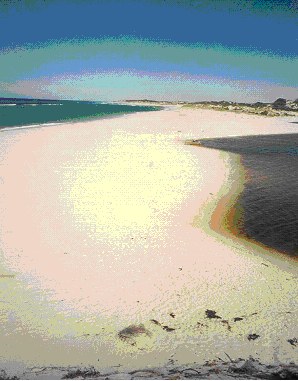
Figure 1. Closed sand barrier separating estuarine waters (right) from marine waters (left). Oldfield Estuary, Western Australia.
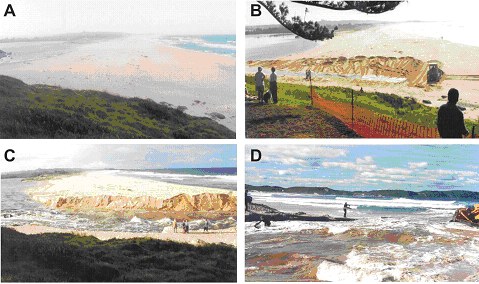
Figure 2. Entrance of Coila Lake, NSW, before (a), during (b) and 1 day after (c) being manually opened by bulldozer (WBM Pty Ltd, April 2002). Entrance of Wilson Inlet, Western Australia (d), in the process of being manually opened by bulldozer.
Dredging
Deepening of existing estuarine entrances and tidal channels through dredging has been conducted in various types of coastal waterways. This generally involves the removal of large quantities of sediment from the seabed to locally deepen waterways. Dredging is typically conducted to increase marine flushing, and aid navigation by removing sediment buildup.
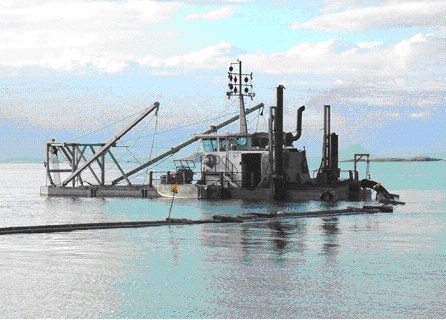
Figure 3. Small dredge vessel pumping sand from the entrance of a boat harbour. Esperance, Western Australia.
Training walls, sea-walls, and groynes
Training walls, sea-walls, and groynes are generally constructions on the margins of coastal waterways comprising rock, cement blocks, or brick work which produce a resistant artificial shoreline. Construction of training walls has been conducted to prevent bank erosion, and also to direct or constrict tidal water flow for the purposes of maintaining channel depth. Training walls may also extend through the entrances of wave dominated systems to maintain a permanently open entrance. Similar artificial walls are often constructed for purposes such as ports, harbours, marina developments, causeways, canal estates, land reclamations or ponded pastures. In the case of Lake Illawarra, NSW, entrance training walls have been constructed to prevent the evaporation of water from the lake when the entrance is blocked by sand, thus avoiding issues associated with desiccation of seagrass beds and resulting odour and poor water quality3. Groynes are a series of small artificial seawalls constructed perpendicular to the shoreline in order to limit long-shore sediment transport. All these structures have the potential to interfere with the long-shore transport of sand. This can lead to sand build up on any structure facing the drift while beach erosion can occur on the “downstream” side. In some cases this has necessitated engineering of “sand bypass” systems (e.g. at Tweed Heads, NSW; Portland and Gippsland Lakes,Victoria).
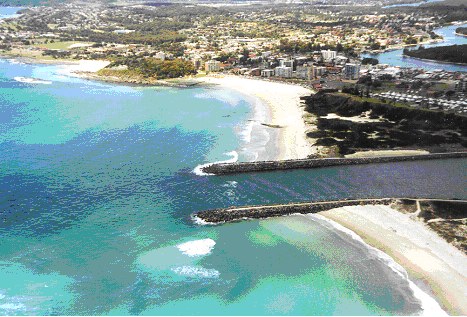
Figure 4. Permanently open entrance and training walls, Wallis Lake, NSW. Photo by David Heggie, 2000.
Barrages and Weirs
Barrages in coastal waterways are walls constructed to limit upstream intrusion of salt water, and also to produce an upstream freshwater reservoir.
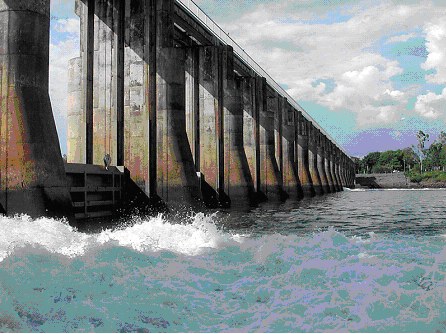
Figure 5. Barrage limiting the upstream penetration of tidal waters in the Fitzroy Estuary, Rockhampton, Queensland. Photo by Bob Packett.
Significance of hydrodynamic alterations
Any alteration to the hydrodynamics of coastal waterways is likely affect the rate and magnitude of tidal-flushing and tidal range within the coastal waterway. Changes to natural timing and magnitude of tidal influence due to modified entrance conditions can have multiple affects on the physical, chemical and biological characteristics of estuaries including:
- Changes in tidal range, mean water levels, and current speeds within the waterway;
- Shoreline alteration due to changes in sediment transport regimes;
- Redistribution of tidal and shallow water habitats e.g. mangroves, saltmarshes and intertidal flats;
- Redistribution of aquatic biota and changes to the diversity and abundance of aquatic biota and assemblages;
- Alteration to estuarine water chemistry such as salinity, dissolved oxygen, turbidity, and nutrients;
- Changes in connectivity between a catchment and the sea affecting fish life cycles.
Following are some specific examples of the documented effects of hydrodynamic alteration seen in Australia.
Effects of intermittent entrance opening on wave dominated systems
In small wave-dominated systems, the frequency of artificial versus natural entrance opening (and closing) has become a topical management issue, and is commonly conducted in New South Wales, Victoria, and south-western Western Australia. This type of alteration can have broad reaching implications, particularly in wave-dominated systems, such as changes in water salinity, temperature, dissolved oxygen, nutrient levels, sediment accumulation patterns, and species composition. Continued artificial opening of estuaries when water levels that are significantly lower than their natural breakout levels can have particularly large impacts on fringing wetlands and associated communities3.
Entrance opening is often advocated because of its impact on social and economic assets such as property and recreational amenity. Increased freshwater flow or over-topping of the entrance bar by high seas can result in raised water levels within the waterway, causing flooding. While these human impacts are readily recognised effects on environmental assets have not been taken into consideration when deciding whether or not to open estuaries1.
From an engineering perspective, timing of an entrance opening to optimise its effectiveness (as measured by the amount of sand scoured from the entrance) is difficult. Factors such as the difference between estuary and sea water level (e.g. a very low ocean tide combined with a very full estuary), sea state, wind direction and tidal range can determine the period of opening. Improper opening technique can lead to insufficient scouring of the sand barrier ‘plug’, rapid subsequent re-closure of the estuary, and future opening difficulties5. Continued artificial opening of the entrance can actually result in more marine sand within the entrance compartment of the estuary, which makes subsequent openings more difficult3.
Scientific studies have found that intermittently opening estuaries have higher abundance of economic (commercially or recreationally fished for) species, due to recruitment of juveniles (into seagrass beds) from the ocean67. Although resident estuarine species may be largely unaffected6, intermittently open and closed estuaries are often found to have higher species diversity than permanently closed systems, but lower species diversity than permanently open estuaries8910. These studies have not dealt with the optimum timing and frequency of entrance opening however. Changes in water level as estuaries open and then close, can have adverse ecological effects such as rotting vegetation and fish kills linked to the re-flooding of recently opened estuaries11, and problems of acid sulfate soil runoff related to lowered estuarine water levels1213. Estuaries with highly variable water levels (due to entrance opening and closure) typically also contain lower percent coverages of seagrass14. Artificial opening of entrances should not be carried out on the basis of ecological gain given the unpredictable outcomes that generally manifest7.
Effects of extended estuarine closure on wave dominated systems
Periods of extended entrance closure are known to have a range of effects on wave dominated estuaries and coastal lagoons. Approximately 70% of NSW estuaries are closed for more than 60% of the time14. Entrance closure affects the movement of biota to and from the sea, which is particularly important for species that need to migrate through estuaries as part of their life cycle. Specific effects can include a decline in marine species, lack of post-larval recruitment, and loss of nursery function4. In arid regions, evaporation can lead to hypersalinity and loss of diversity (and economic species), whereas conversely, salinity can approach zero and the depth of the waterway increases with extended catchment rainfall615. Additionally, the impacts of catchment development and pollution may be exacerbated if marine flushing is prevented, increasing eutrophication and odour problems1617. Seagrass beds are also dependant on intermediate water depths, with over-deepening (and changes in water chemistry/epiphytes) having deleterious impacts14.
There are, however, important benefits to the ecology of estuaries associated with, extended periods of elevated water levels. Fringing wetlands, saltmarshes and mangrove communities require periodic inundation as a vital part of their life cycles. Interestingly, a number of estuaries on the north coast of NSW contain mangroves that have extended pneumatophores (vertical peg roots) of up to 100cm long, as well as adventitious roots, in order to cater for significant water level variations3. Juvenile fish utilise the flooded margins of estuaries for shelter and feeding. During times of drought the flooded estuaries provide important drought refugia when inland waterways have dried up1. In addition artificial opening of stratified estuaries in Victoria has resulted in fish kills18 and the loss of floating eggs of fish such as the black bream to the ocean19. This appears to be one reason for whole year classes of fish being absent from estuary populations.
The decision to open or not open an estuary entrance must be based on a careful consideration of the threats to economic, social and environmental assets of either decision. Decision Support Systems have been developed to assist managers with these decisions. Artificial entrance opening is a short-term and often expensive, solution to prevent inundation of low-lying property, flooding, water quality and odour problems. Longer term, sustainable solutions involving relocating inappropriately sited buildings, installation of floating jetties and nutrient management in catchments are also required.
Permanent opening of wave dominated systems
The installation of cement or rubble block training walls to open or widen estuary mouths for navigation purposes, results in permanent hydrological changes such as increased tidal penetration and greater tidal range within the coastal waterway. Examples of such alterations include the Swan River (WA), Wagonga Inlet (NSW) and Wallis Lake (NSW). Permanent opening of coastal waterways typically has similar initial effects as entrance modification, however a new equilibrium is often reached. Scientific studies have shown that the species richness and diversity is consistently higher in open waterways compared to closed, including both economic finfish species and particularly invertebrates917. However, other work suggests that intermittently open lagoons can support larger fisheries (depending on the species sought) than permanently open systems, possibly because species cannot escape to the ocean when the estuary is closed8.
The construction of training walls, seawalls, or groynes along foreshores typically results in a loss of foreshore habitat, and the disturbance and probable loss of intertidal habitat20. Depending on the composition, structure, and exposure of the rock wall, habitat area suitable for benthic organisms can be either increased or decreased21. Additionally, rock walls can increase wave energy within the waterway, due to the reflection of waves from the shoreline.
Channel Dredging
Dredging can have a number of effects on an estuary, primarily increasing the size and speed of current flows, and tidal range. Activities such as dredging tend to widen or deepen the entrance channel, allowing greater tidal penetration. For example, extraction of 760,000 m3 of sand from the entrance of the Tweed River affected tidal water levels by up to 0.3 m and tidal flows throughout the entire estuary5. Seagrass beds and other seabed habitats may be destroyed by mining the underlying sediment or degraded by increased levels of turbidity and sedimentation. Any deep holes and channels created by dredging can become stagnant, or may affect current flow patterns20. In addition to this, dredging of sediment from the seabed creates the problem of disposal of dredged material, which may lead to local smothering and over-sedimentation, and potential redistribution of sediment-bound pollutants.
Summary
Estuarine biota may respond directly or indirectly to estuary entrance management, with potential impacts on their abundances, species composition (see for example diatom species), diversity, biomass, growth rates and survival. Impacts such as these not only affect the estuarine ecology, they also impact on the aesthetic, social and economic value of estuaries. Effects of a decision to open or not open are complex and may be positive or negative. For example, estuary closure may increase the frequency and duration of algal blooms, flooding, odour problems or the loss of economically important finfish harvests. It may also provide excellent water bird habitat, important refugia for juvenile fish and increase the vigour of fringing plant communities such as saltmarsh. While opening may improve flushing of some estuaries in others it has been shown to cause mass mortalities of fish and other estuarine organisms.
However, positive impacts of artificial opening are also possible, however are not well understood, and may include reduction in turbidity (aesthetic), and increased presence of commercial marine species. It is important that entrance management be informed by the best available science and that community education on the issues be given a high priority by estuary managers.
Existing information and data
Contributors
David Ryan, Geoscience Australia
John Sherwood, Deakin University
Phillip Haynes, WBM Oceanics Australia.
- Arundell H., 2006. Estuary Entrance Management Support System (EEMSS) Deakin University, Warrnambool Victoria Australia, Prepared for Glenelg-Hopkins CMA. ↩ ↩ ↩
- Thompson M.J. 2006. The Role of Science in the Management of Estuaries in Southeastern Australia PhD Thesis, Dept of Earth and Environmental Sciences, University of Wollongong, NSW, Australia. ↩
- Haines, P.E. 2006. Physical and chemical behaviour and management of Intermittently Closed and Open Lakes and Lagoons (ICOLLs) in NSW. PhD thesis, Griffith University, 506 pp ↩ ↩ ↩ ↩ ↩
- Vivier, L., Cyrus, D.P., 2002. Ichthyofauna of the sub-tropical Nhlabane Estuary, KwaZulu-Natal: drought-related changes in the fish community during extended mouth closure. Marine and Freshwater Research 53, 457-464. ↩ ↩
- NSW Department of Natural Resources, 2006. Estuaries in NSW, website: http://www.environment.nsw.gov.au/estuaries/index.htm ↩ ↩
- Griffiths, S.P., 1999. Consequences of artificially opening coastal lagoons on their fish assemblages. International Journal of Salt Lake Research 8(4), 307-327. ↩ ↩ ↩
- Jones, M.V., West, R.J., 2005. Spatial and temporal variability of seagrass fishes in intermittently closed and open coastal lakes in southeastern Australia. Estuarine, Coastal and Shelf Science 64, 277-288. ↩ ↩
- Pollard, D.A., 1994. A comparison of fish assemblages and fisheries in intermittently open and permanently open coastal lagoons on the south coast of New South Wales, south-eastern Australia. Estuaries 17, 631-646. ↩ ↩
- Teske, P.R., Wooldridge, T., 2001. A comparison of the macrobenthic faunas of permanently open and temporarily open/closed South African estuaries. Hydrobiologia 464, 227-243. ↩ ↩
- Saintlan, N., 2004. Relationships between estuarine geomorphology, wetland extent and fish landings in New South Wales estuaries. Estuarine, Coastal and Shelf Science 61, 591-601. ↩
- Wilson, J., Evans, P., Kelleher, N., 2002. Fish kills in Cockrone Lagoon – Implications for entrance openings of coastal lakes. Proceedings of Coast to Coast 2002 – Source to Sea, pp. 101-104, Tweed Heads. ↩
- Callinan, R.B., Fraser G.C. Melville M.D., 1992. Seasonally recurrent fish mortalities and ulcerative disease outbreaks associated with acid sulphate soils in Australian estuaries. In Dent D.L. and van Mensvoort M.E.F.(eds) Ho Chi Minh City Symposium on Acid Sulphate Soils. International Institute for Land Reclamation and Improvemment, Ho Chi Minh City, Vietnam, pp403 – 410. ↩
- Wilson, B.P., White, I., Melville, M.D., 1999. Floodplain hydrology, acid discharge and change in water quality associated with a drained acid sulphate soil. Marine and Freshwater Research 50, 149-157. ↩
- Haines, P.E., Tomlinson, R.B., Thom, B.G., 2006. Morphometric assessment of intermittently open/closed coastal lagoons in New South Wales, Australia. Estuarine Coastal and Shelf Science 67, 321-332. ↩ ↩ ↩
- Young, G.C., Potter, I.C., 2002. Influence of exceptionally high salinities, marked variations in freshwater discharge and opening of estuary mouth on the characteristics of the ichthyofauna of a normally-closed estuary. Estuarine, Coastal and Shelf Science 55, 223-246. ↩
- Murray, E., Heggie, D., 2002. Hydrogen sulphide production in Lake Wollumboola, NSW South Coast. Geoscience Australia Professional Opinion, 2002/02, 47 pp. ↩
- Dye, A., Barros, F., 2005. Spatial patterns of macrofaunal assemblages in intermittently closed/open coastal lakes in New South Wales, Australia. Estuarine Coastal and Shelf Science 64, 357-371. ↩ ↩
- Sherwood, unpublished data ↩
- Nicholson, G., Sherwood, J., Jenkins, G., Longmore, A., 2004. Effects of Environmental flows on the spawning success of resident black bream in estuarine environments. Primary Industries Research, Queenscliff, Victoria. Report No. 23, June 2004, 68 pp. ↩
- Scheltinga, D.M., Counihan, R., Moss, A., Cox, M., Bennett, J., 2004. Users guide to estuarine, coastal and marine indicators for regional NRM monitoring. Cooperative Research Centre for Coastal Zone, Estuary & Waterway Management Report to DEH, MEWG, ICAG, Revised Version, December 2004, 198 pp. ↩ ↩
- Underwood, A.J., Kingsford, M.J., Andrew, N.L., 1991. Patterns in shallow subtidal marine assemblages along the coast of New South Wales. Australian Journal of Ecology 16, 231-249. ↩


